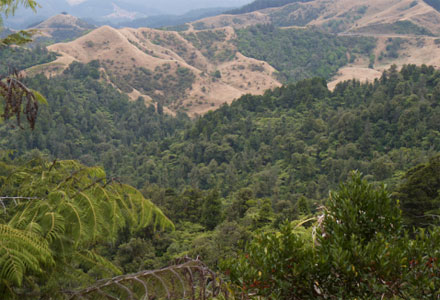A hybrid approach of planting both exotics and natives will produce more socio-economic and environmental benefits, says regional leadership governance group Rau Tipu Rau Ora. Source: Gisborne Herald
At a meeting on Friday the group presented its “position statement” on managing exotic afforestation incentives consultation submission directly to Minister of Forestry Stuart Nash, who was in Gisborne.
The submission was made to show the group’s position in relation to the Government proposal, put forward earlier this year, to exclude exotics from the permanent category for Emissions Trading Scheme (ETS) incentives, with submissions closing last month.
Pakihiroa Farms Limited general manager and member of the governance group Hilton Collier officially presented the position statement on behalf of Rau Tipu Rau Ora.
“Our RTRO position was that we did not want to take exotics out of the ETS permanent forest category but if exotics are to be excluded from this category, then there are circumstances where they need to be permitted via secondary legislation,” he said.
The submission document said the Government should enable a more mosaic approach to afforestation — such as planting the right tree in the right place, for the right reason.
A hybrid approach allowing growth of both exotic and native species at suitable locations would help recover highly erodible lands in the region.
Mr Collier said soil erosion was a major issue in Tairāwhiti.
With most of the region having land use categories of 6,7 and 8, most areas were deemed to be at risk of erosion.
The submission document said fast-growing exotic species were necessary to address such problems in specific sites.
“The current MPI Lookup tables show in 16 years of growth, pine sequesters 443 tonnes of carbon versus 137t from indigenous. At the current price of $75/tonne that’s a significant difference in revenue.
“The only activity on the worst of class 7 and 8 lands is permanent forest. A mixed regime of exotics and natives should provide short-term soil stability allowing for the transition to indigenous over time,” he said.
RTRO co-chair Selwyn Parata said the group supported efficient land use by thinking of sustainability on a long-term basis.
“We support ‘the right activity, in the right place for the right reason’ approach to the proposed ETS changes,” he said.
The submission document said the proportion of land use category (LUC) 7 and 8 made the region a target for afforestation.
Despite the group’s support for afforestation, it noted that there could be disruptions to the regional economy if government policy settings resulted in “poorly managed or located permanent large-scale afforestation in Tairāwhiti.”
Having a balanced land use practice such as permanent carbon farming, plantation forestry and agriculture was crucial to food production in the region and the agricultural sector workforce.
RTRO co-chair and Mayor Rehette Stoltz echoed the sentiments of the submission and said the group was also opposed to “lock up and leave ETS regimes”.
Mr Collier said with 88% of land in the region coming under classes 6, 7 and 8, it was likely to be targeted for tree planting.
“There is a fear this will bring ‘lock up and leave’ carbon-sink forest that creates subsequent environmental problems and doesn’t contribute to our regional economy.”
Mr Parata said it was also important to recognise that specific equity considerations needed to be given for Whenua Māori, “recognising historical inequities, Treaty settlement obligations, and the multi-billion investments in forestry that iwi and Māori landowners have”.
The submission document said Tairāwhiti as a region was one of the largest forestry employers in the North Island, amounting to 10 percent of the workforce.
“Therefore, changes to the forestry settings will impact a large proportion of the region’s workforce, with multiple socio-economic impacts.”
Māori comprised more than half the population of the region, with most of their best lands with productive soil having been lost due to discriminatory policies and practices, said the document.
Mr Collier said at present 28% of land here was Whenua Maori and much of that land was more than 80km from Gisborne’s port.
“This land is unlikely to be economic to log, so the ETS provides an important revenue stream source for those owners who planted forest, as the joint ventures they entered were the only way they could raise capital.
“The cost to establish exotic forests is about NZ$2500/ha — much less than the NZ$6000/ha or more for indigenous forests.”
The document said Maori have invested “heavily” in forestry over the years.
“The removal of exotics from the permanent forestry category in the ETS will significantly impact forestry investment on Whenua Māori and create ripple impacts for current and future generations of Māori.
“Without support to make other forest types financially viable, permanent exotic forests in remote areas, where the harvest is not economically or environmentally feasible, are a means to provide income from Whenua Māori,” the document said.
Changes to national policy or regulatory settings had the potential to cause further barriers to the development and prospective revenues of Whenua Māori.
The Rau Tipu Rau Ora governance group was established in June 2020 to develop, lead, champion and oversee the preparation and implementation of the Tairawhiti Covid-19 Pandemic Response and Recovery Plan. Its four priority focus areas include economic, environment, whanau, and community and workforce development






